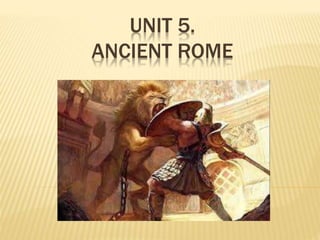
Unit 5. Ancient rome
- 2. THE ORIGINS OF ROME The origin of Roman civilisation is in the city of Rome. It was founded in the eighth century BC on the banks of the River Tiber, in the Italian Peninsula, in an area of easy protection, as it was surrounded by seven hills.
- 3. The territory in which it settled was called Latium, which was inhabited by the Latins. Before its foundation, the Italian Peninsula was populated by Latins (in the centre), the Greeks (in the south) and the Etruscans (in the north). The Etruscans, in the 6th century BC, conquered and gained control of Latium. THE ORIGINS OF ROME
- 4. THE LEGEND OF ROMULUS AND REMUS According to legend, Rome was founded in Palatine Hill by Romulus in 753 BC. The twins Romulus and Remus were put in a basket in the River Tiber. A she-wolf found the babies and fed them her milk. Later a shepherd adopted the boys. When the boys grew up, they decide to build a city by the River Tiber. One day, they argue and Romulus kills Remus. Romulus became de first King!
- 5. You have the video available at the following link: https://www.youtube.com/watch?v=7Pp83xYOttc
- 6. SYSTEMS OF GOVERNMENT Roman history is divided into three periods:
- 7. THE MONARCHY (753 - 509 BC) Romulus was de first King of Rome. Later, the city was occupied by the Etruscans. From its foundation until the year 509 BC, Rome was ruled by seven Kings. The first four were Latins and the final three were Etruscans. The last Etruscan king, Tarquin the Proud, was deposed because he was a tyrant. The King ruled with the help of the Senate (made up of patricians), an advisory assembly with no decision-making powers. Therefore, the kind had all the power to make any decision.
- 8. The citizens elected the government (a kind of democracy). Power was shared between Comitias, Magistrates and the Senate. THE SENATE The senate was a council of citizens from the most important families : PATRICIANS It was responsible for deciding foreing policy and upholding decisions made by the comitians COMITIAS These were assemblies, formed by citizens , in wich magistrates were chosen, laws were passed and decisions about going to war were taken MAGISTRATES These were annually elected by the comitias. The most important magistrates were: Consuls, Tribunes of the plebeians and dictator. THE ROMAN REPUBLIC (509 – 27 BC)
- 9. In The Republic… Initially, the patricians still held all the power. Only they could be part of the Senate, and only they could hold public office. The patricians in the Senate made laws, patricians and consuls executing them, and patricians were also the judges who punished the lawbreakers. Because of this, the plebeians began to fight for their rights, which were established in the Law of the Twelve Tables. During this time, took place the Three Punic wars that faced Romans and Carthaginians. The Romans emerged victorious in all the battles and, consequently, Rome had control of the Mediterranean Sea (Mare Nostrum) and others places, such as the Iberian Peninsula. The Republic ended when some magistrates and generals (with so much power), including Julius Caesar (and also Pompey and Crassus), took control of the government of Rome. In 48 BC, Caesar was proclaimed perpetual dictator, with all the power.
- 10. JULIUS CAESAR In 100 BC, Julius Caesar was born in Rome. He was from an important family, so in 61 BC he became governor of Spain. Next Caesar went to fight the Gauls in France. He was a brilliant general, and he conquered all of France. Caesar’s soldiers loved him, but the Senator Pompey thought he was too powerful, so he ordered him to return to Rome. Caesar went to Rome, but he brought his army with him, and started a civil war with Pompey. Caesar wan, and Pompey was killed. Caesar made himself consul and dictator for life. The senators were afraid that Caesar wanted to be king, so they murdered him in 44 BC.
- 11. THE ROMAN EMPIRE (27 BC – 476 AD) It began in 27 BC, when the Senate gave political and religious power to Augustus (Octavian). Augustus held all power and the political institutions lost their importance. The titles of Augustus: Imperator (leader of the military), Princeps (first citizen of the Senate), Augustus (put him on the same level of the gods), Pontifex Maximus (highest religious authority in the Empire). Some of the most important episodes were: Pax romana. A long period of peace in Rome. This period lasted two centuries: the 1st and 2nd centuries AD. Territorial conquest. The Empire reached its maximum size. Emperor Caracalla granted citizenship to all free man in the Roman Empire (year 212). Edict of Milan (year 313): Emperor Constantine allowed freedom of worship. Edict of Thessalonica (year 380): Emperor Theodosius proclaimed Christianity official religion. Crisis of the third century. The empire went into decline.
- 12. CONQUEST OF THE MEDITERRANEAN
- 13. CRISIS AND FALL OF THE EMPIRE Starting in the 3rd century AD. WHY? - Political instability: increased military power, attack of the barbarians, political corruption… - Economic instability: shortage of slaves, drop in production, trade weakened… - Social instability: social unrest, - Division of the Empire by Theodosius (395 BC). Emperor Theodosius divided the Empire into two parts: 1. The Western Roman Empire, with Rome as capital. 2. The Eastern Roman Empire, with its capital in Constantinople (Hard thousand years).
- 14. In 476 AD , the Germanic people deposed the last Emperor (Romulus Augustus) of the Western Roman Empire. It was the ended of the Roman Empire. AND ALSO THE END OF ANCIENT HISTORY!!!!!! AND THE START OF THE MIDDLE AGES!!!! FALL OF THE EMPIRE
- 15. You have the video available at the following link: https://www.youtube.com/watch?v=L_7f-k9sq7U
- 16. THE END THANKS YOU FOR YOUR ATTENTION